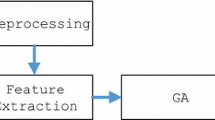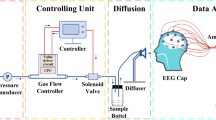Abstract
To deal with unknown odor recognition problem for a developed artificial odor discrimination system, Euclidean Fuzzy similarity-based Self-Organized Network inspired by Immune Algorithm (EF-SONIA) is proposed. Euclidean fuzzy similarity enables a zero similarity calculation between an unknown odor vector and hidden unit vectors, so that the system can recognize the unknown odor. In addition, an elliptical approach for fuzziness determination is proposed. The elliptical approach can approximate an appropriate fuzziness, so that the unknown odor recognition accuracy is improved. Experiments on three datasets of three-mixture vegetal odors show that the recognition accuracy of the proposed method is 20% better than those of the conventional method. The system is very promising to be used for a real development of dog robot that enables localization and identification of dangerous natural gas.







Similar content being viewed by others
References
Shurmer HV, Gardner JW (1992) Odor discrimination with an electronic nose. Sensors Actuators B 8:1–11
Gardner JW, Bartlett PN (1994) A brief history of electronic noses. Sensors Actuators B 18–19:211–220
Nagle HT, Schiffman SS, Osuna RG (1998) The how and why of electronic noses. IEEE Spectr 35(9):22–34
Kusumoputro B, Widyanto MR, Fanany MI, Budiarto H (1999) Improvement of artificial odor discrimination system using FLVQ neural network. In: Proceedings of the 3rd International Conference on Computational Intelligence and Multimedia Application, New Delhi, India, pp 474–478
Romain AC, Nicholas J, Wiertz V, Maternova J, Andre P (2000) Use of simple tin oxide sensor array to identify five malodors collected in the field. Sensors Actuators B 62:73–79
Singh VK, Dwivedi D, Srivastava SK (1999) Minimum difference method: an approach for discrimination of individual gases/odors using an integrated sensor array. Microelectr J 30:55–58
Marcelloni F (2001) Recognition of oilfactory, signals based on supervised fuzzy c-means and k-NN algorithms. Pattern Recognit Lett 22:1007–1019
Gardner JW, Shin HW, Hines EL, Dow CS (2000) An electronic nose for monitoring the quality of potable water. Sensors Actuators B 69:336–341
Pavlou AK, Magan N, Sharp D, Brown J, Barr H, Turner APF (2000) An intelligent rapid odor recognition in discrimination of Helicobacter pylori and other gastroesopagheal isolates in vitro. Biosens Bioelectron 15:333–342
Distante C, Siciliano P, Vasanelli L (2000) Odor discrimination using adaptive resonance theory. Sensors Actuators B 69:248–252
Kermani BG, Schiffman SS, Troy Nagle H (2005) Performance of the Levenberg–Marquardt neural network training method in electronic nose applications. Sensors Actuators B Chem 110(1):13–22
Onkal-Engin G, Demir I, Engin SN (2005) Determination of the relationship between sewage odour and BOD by neural networks. Environ Model Softw 20(7):843–850
Reznik AM, Galinskaya AA, Dekhtyarenko OK, Nowicki DW (2005) Preprocessing of matrix QCM sensors data for the classification by means of neural network. Sensors Actuators B Chem 106(1):158–163
Janes KR, Yang SX, Hacker RR (2004) Single-component modelling of pig farm odour with statistical methods and neural networks. Biosyst Eng 88(3):271–279
Brudzewski K, Osowski S, Markiewicz T (2004) Classification of milk by means of an electronic nose and SVM neural network. Sensors Actuators B Chem 98(2–3):291–298
Daqi G, Shuyan W, Yan J (2004) An electronic nose and modular radial basis function network classifiers for recognizing multiple fragrant materials. Sensors Actuators B Chem 97(2–3):391–401
Sohn JH, Smith R, Yoong E, Leis J, Galvin G (2003) Quantification of odours from piggery effluent ponds using an electronic nose and an artificial neural network. Biosyst Eng 86(4):399–410
Widyanto MR, Kusumoputro B, Nobuhara H, Kawamoto K, Hirota K (2006) A fuzzy similarity based self-organized network inspired by immune algorithm for three mixture fragrances recognition. IEEE Trans Ind Electr 53(1):313–321
Skarda CA, Freeman WJ (1987) How brains make chaos in order to make sense of the world. Behav Brain Sci 10:161–195
Sauerbrey G (1959) Verwedung von schwingquaren zur wagung dunner shichten und zur mikrowagung. Z Phys 155:206–222
Widyanto MR, Kusumoputro B, Nobuhara H, Kawamoto K, Hirota K (2005) Improving recognition and generalization capability of back-propagation NN using a self-organized network inspired by immune algorithm. Appl Soft Comput 6:1
Rumelhart DE, Hinton GE, Williams RJ (1986) Learning representations by error propagation. Nature 323:533–536
Timmis JI (2001) Artificial immune systems: a novel data analysis technique inspired by the immune network theory. Ph.D. Dissertation, University of Wales, Aberystwyth
Zadeh LA (1971) Similarity relations and fuzzy orderings. Inf Sci 3:177–200
Haykin S (1999) Neural networks. Prentice Hall, Englewood Cliffs
Evans CW (1992) Engineering mathematics. Chapman & Hall, London
Kohonen T (1986) Learning vector quantization for pattern recognition. Technical Report TKK-F-A601, Helsinki University of Technology, Finland
Kangas J, Kohonen T (1996) Developments and applications of the self-organizing map and related algorithms. Elsevier Math Comput Simul 41:3–12
Sakuraba Y, Nakamoto T, Moriizumi T (1991) New method of learning vector quantization. Syst Comput Jpn 22(13):93–102
Demuth H, Beale M (2001) Neural networks toolbox. Matlab 6.1 User Guide, Mathworks
Author information
Authors and Affiliations
Corresponding author
Rights and permissions
About this article
Cite this article
Widyanto, M.R., Kusumoputro, B. & Hirota, K. Unknown odor recognition using Euclidean Fuzzy similarity-based Self-Organized Network inspired by Immune Algorithm. Neural Comput & Applic 17, 27–37 (2008). https://doi.org/10.1007/s00521-007-0105-y
Received:
Accepted:
Published:
Issue Date:
DOI: https://doi.org/10.1007/s00521-007-0105-y




